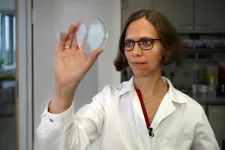Biopolymer-coated nanocatalyst can help realize a hydrogen fuel-driven future
Scientists demonstrate enhanced hydrogen production from sunlight-assisted water splitting using a polydopamine-coated zinc sulfide nanorod catalyst
2021-02-23
(Press-News.org) To combat climate change, shifting from fossil fuels to clean and sustainable energy sources is imperative. A popular candidate in this regard is hydrogen, an eco-friendly fuel that produces only water when used. However, the efficient methods of hydrogen production are usually not eco-friendly. The eco-friendly alternative of splitting water with sunlight to produce hydrogen is inefficient and suffers from low stability of the photocatalyst (material that facilitates chemical reactions by absorbing light). How does one address the issue of developing a stable and efficient photocatalyst?
In a study recently published in Applied Catalysis B: Environmental, an international group of scientists, led by Assistant Professor Yeonho Kim from Incheon National University in Korea, addressed this question and reported on the performance of polydopamine (PDA)-coated zinc sulfide (ZnS) nanorods as a photocatalyst, which showed an increase in hydrogen production by 220% compared to ZnS catalyst alone! Moreover, it displayed decent stability, retaining almost 79% of its activity after being irradiated for 24 hours. Dr. Kim outlines the motivation behind their research, "ZnS has various photochemical applications because it can rapidly generate electric charge carriers under sunlight. However, sunlight also causes oxidation of sulfide ions leading to photocorrosion of ZnS. Recently, studies showed that controlled-thickness PDA coatings on a photocatalyst can improve conversion efficiency for solar energy and enhance photostability. But, so far, no study has addressed the physico-chemical changes at the interface of ZnS/PDA. Therefore, we wanted to study the effect of PDA binding on the photocatalytic performance of ZnS."
The scientists fabricated the PDA-coated ZnS nanocatalysts through polymerization to coat dopamine onto ZnS nanorods, and varied the polymerization period to create samples of three different PDA thicknesses--1.2 nm (ZnS/PDA1), 2.1 nm (ZnS/PDA2), and 3.5 nm (ZnS/PDA3). They then measured the photocatalytic performance of these samples by monitoring their hydrogen production under simulated sunlight illumination.
The ZnS/PDA1 catalyst showed the highest hydrogen production rate followed by ZnS/PDA2, uncoated ZnS, and ZnS/PDA3. The team attributed the inferior performance of ZnS/PDA2 and ZnS/PDA3 to more light absorption by the thicker PDA coatings, which reduced the light reaching ZnS and impeded the excited charge carriers to reach the surface; uncoated ZnS, contrarily, underwent photocorrosion.
To understand the role of electronic structure in the observed enhancement, the scientists measured emission and extinction spectra of the samples along with density functional theory calculations. The former revealed that the enhanced absorption was due to Zn-O or O-Zn-S shells forming on ZnS and the creation of energy levels near the valence band (highest atomic level filled with electrons) that can accept "holes" (absence of electrons), while the calculations showed that ZnS/PDA has a unique "doubly staggered" electronic structure that facilitates the transport and separation of charge carriers at the surface. The improved durability was due to lowered oxidative capacity of holes in the valence states of PDA.
Dr. Kim and his team are hopeful of wider applications of their technique. "The polydopamine coating utilized in our work is also applicable to other groups of selenide, boride, and telluride-based catalysts," comments Dr. Kim.
The future might indeed be hydrogen!
INFORMATION:
About Incheon National University
Incheon National University (INU) is a comprehensive, student-focused university. It was founded in 1979 and given university status in 1988. One of the largest universities in South Korea, it houses nearly 14,000 students and 500 faculty members. In 2010, INU merged with Incheon City College to expand capacity and open more curricula. With its commitment to academic excellence and an unrelenting devotion to innovative research, INU offers its students real-world internship experiences. INU not only focuses on studying and learning but also strives to provide a supportive environment for students to follow their passion, grow, and, as their slogan says, be INspired.
Website: http://www.inu.ac.kr/mbshome/mbs/inuengl/index.html
About the author
Dr. Yeonho Kim is an Assistant Professor of Research Institute of Basic Sciences at Incheon National University. His research group is developing environmentally-friendly (photo) catalysts of the nanoscale range and studying their reduction/oxidation mechanism during the photocatalytic reaction. His group aims to overcome challenges in present catalysts technologies using alternative oxidation half-reactions to drive the breakdown of waste polymers or chemicals into valuable organic products.
[Attachments] See images for this press release:

ELSE PRESS RELEASES FROM THIS DATE:
2021-02-23
Having a memory of past events enables us to take smarter decisions about the future. Researchers at the Max-Planck Institute for Dynamics and Self-Organization (MPI-DS) and the Technical University of Munich (TUM) have now identified how the slime mold Physarum polycephalum saves memories - although it has no nervous system.
The ability to store and recover information gives an organism a clear advantage when searching for food or avoiding harmful environments. Traditionally it has been attributed to organisms that have a nervous system.
A new study authored by Mirna Kramar (MPI-DS) and Prof. Karen Alim (TUM and MPI-DS) challenges this view by uncovering the surprising abilities of a highly dynamic, single-celled organism to store and ...
2021-02-23
During ice ages, the global mean sea level falls because large amounts sea water are stored in the form of huge continental glaciers. Until now, mathematical models of the last ice age could not reconcile the height of the sea level and the thickness of the glacier masses: the so-called Missing Ice Problem. With new calculations that take into account crustal, gravitational and rotational perturbation of the solid Earth, an international team of climate researchers has succeeded in resolving the discrepancy, among them Dr. Paolo Stocchi from the Royal Netherlands Institute for Sea Research (NIOZ). The study, now published in the ...
2021-02-23
During this unique study, a team of researchers led by Professor Jane Ogden from the University of Surrey investigated the impact of actively preparing or watching others prepare food (e.g., on a cooking show) versus distraction away from this focus. Researchers sought to understand how this may affect the amount of food consumed and influence the desire to continue eating.
To investigate this further, eighty female participants were recruited and assigned to one of four groups: active food preparation (preparing a cheese wrap within 10 minutes), video food preparation (watching a video of a researcher preparing a cheese wrap), distraction ...
2021-02-23
University of Alberta researchers have found that limiting the amount of fat the body releases into the bloodstream from fat cells during heart failure could help improve outcomes for patients.
In a recent study published in the American Journal of Physiology, Jason Dyck, professor of pediatrics in the Faculty of Medicine & Dentistry and director of the U of A's Cardiovascular Research Centre, found that mice with heart failure that were treated with a drug blocking the release of fat into the bloodstream from fat cells saw less inflammation in the heart and throughout the body, and had better outcomes than a control group.
"Many people believe that, by definition, heart failure is only ...
2021-02-23
New Orleans, LA - An LSU Health New Orleans School of Public Health study reports a positive association between social vulnerability and COVID-19 incidence at the census tract level and recommends that more resources be allocated to socially vulnerable populations to reduce the incidence of COVID-19. The findings are published in Frontiers in Public Health, available END ...
2021-02-23
Gay men are more likely than lesbian women to face stigma and avoidant prejudice from their heterosexual peers due to the sound of their voice, a new study in the British Journal of Social Psychology reports. Researchers also found that gay men who believe they sound gay anticipate stigma and are more vigilant regarding the reactions of others.
During this unique study researchers from the University of Surrey investigated the role of essentialist beliefs -- the view that every person has a set of attributes that provide an insight into their identity -- of heterosexual, lesbian ...
2021-02-23
In Wonderland, Alice drank a potion to shrink herself. In nature, some animal species shrink to escape the attention of human hunters, a process that takes from decades to millennia. To begin to understand the genetics of shrinking, scientists working at the Smithsonian Tropical Research Institute (STRI) in Panama successfully extracted DNA from marine shells. Their new technique will not only shed light on how animals from lizards to lemurs shrink, it will reveal many other stories hidden in shells.
"Humans are unique as predators," said Alexis Sullivan, doctoral student at Penn ...
2021-02-23
OAK BROOK, Ill. - A machine learning algorithm helps accurately differentiate benign and premalignant colorectal polyps on CT colonography scans, according to a study published in the journal Radiology.
Colorectal cancer is among the three most common causes of cancer-related death among men and women in industrialized countries. Most types of colorectal cancer originate from adenomatous polyps--gland-like growths on the mucous membrane lining the large intestine--that develop over several years. Early detection and removal of these precancerous polyps can reduce the incidence and mortality of colorectal cancer.
During the last two decades, CT colonography emerged as a noninvasive ...
2021-02-23
Peer review/observational study/people
In patients with severe COVID-19, the innate immune system overreacts. This overreaction may underlie the formation of blood clots (thrombi) and deterioration in oxygen saturation that affect the patients. This is shown in an Uppsala University study published in the journal Frontiers in Immunology.
Blood contains numerous proteins that constitute the body's primary barrier, by both recognising and destroying microorganisms, including SARS-CoV-2 (the virus that causes COVID-19). These proteins are part of the intravascular innate immune system (IIIS), which consists of certain white blood cells, platelets and what are known as the cascade systems of the blood.
Only 5 ...
2021-02-23
Glaciers in West Antarctica are moving more quickly from land into the ocean, contributing to rising global sea levels. A 25-year record of satellite observations has been used to show widespread increases in ice speed across the Getz sector for the first time, with some ice accelerating into the ocean by nearly 50%.
The new study, led by the University of Leeds, reports that 14 glaciers in the Getz region are thinning and flowing more quickly into the ocean. Between 1994 and 2018, 315 gigatonnes of ice has been lost, adding 0.9 mm to global mean sea level - equivalent to 126 million Olympic swimming pools of water.
The results published today (19/02/2021) in the journal Nature Communications show that, on average, ...
LAST 30 PRESS RELEASES:
[Press-News.org] Biopolymer-coated nanocatalyst can help realize a hydrogen fuel-driven future
Scientists demonstrate enhanced hydrogen production from sunlight-assisted water splitting using a polydopamine-coated zinc sulfide nanorod catalyst





